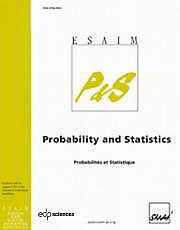Crossref Citations
This article has been cited by the following publications. This list is generated based on data provided by
Crossref.
Giraitis, Liudas
and
Surgailis, Donatas
2002.
ARCH-type bilinear models with double long memory.
Stochastic Processes and their Applications,
Vol. 100,
Issue. 1-2,
p.
275.
Hurvich, Clifford M.
Moulines, Eric
and
Soulier, Philippe
2005.
Estimating Long Memory in Volatility.
Econometrica,
Vol. 73,
Issue. 4,
p.
1283.
Beran, Jan
2006.
On location estimation for LARCH processes.
Journal of Multivariate Analysis,
Vol. 97,
Issue. 8,
p.
1766.
Dalla, Violetta
Giraitis, Liudas
and
Hidalgo, Javier
2006.
Consistent estimation of the memory parameter for nonlinear time series.
Journal of Time Series Analysis,
Vol. 27,
Issue. 2,
p.
211.
Deo, Rohit
Hsieh, Mengchen
Hurvich, Clifford M.
and
Soulier, Philippe
2006.
Dependence in Probability and Statistics.
Vol. 187,
Issue. ,
p.
221.
Abadir, Karim M.
Distaso, Walter
and
Giraitis, Liudas
2007.
Semiparametric Estimation and Inference for Trending I(D) and Related Processes.
SSRN Electronic Journal,
Haug, Stephan
and
Czado, Claudia
2007.
An Exponential Continuous-Time GARCH Process.
Journal of Applied Probability,
Vol. 44,
Issue. 4,
p.
960.
Giraitis, Liudas
Leipus, Remigijus
and
Surgailis, Donatas
2007.
Long Memory in Economics.
p.
3.
Haug, Stephan
and
Czado, Claudia
2007.
An Exponential Continuous-Time GARCH Process.
Journal of Applied Probability,
Vol. 44,
Issue. 04,
p.
960.
Giraitis, Liudas
Leipus, Remigijus
and
Surgailis, Donatas
2009.
Handbook of Financial Time Series.
p.
71.
Hurvich, Clifford M.
and
Soulier, Philippe
2009.
Handbook of Financial Time Series.
p.
345.
Beran, Jan
and
Schützner, Martin
2009.
On approximate pseudo-maximum likelihood estimation for LARCH-processes.
Bernoulli,
Vol. 15,
Issue. 4,
Doukhan, Paul
Klesov, Oleg
and
Lang, Gabriel
2010.
Rates of convergence in some SLLN under weak dependence conditions.
Acta Scientiarum Mathematicarum,
Vol. 76,
Issue. 3-4,
p.
683.
Abadir, Karim M.
Distaso, Walter
and
Giraitis, Liudas
2011.
An I(<i>d</i>) Model with Trend and Cycles.
SSRN Electronic Journal,
Abadir, Karim M.
Distaso, Walter
and
Giraitis, Liudas
2011.
An I() model with trend and cycles.
Journal of Econometrics,
Vol. 163,
Issue. 2,
p.
186.
Wang, L.
2011.
L 1-estimation for the location parameters in stochastic volatility models.
Mathematical Methods of Statistics,
Vol. 20,
Issue. 2,
p.
165.
Kalli, Maria
and
Griffin, Jim E.
2011.
Flexible Modelling of Dependence in Volatility Processes.
SSRN Electronic Journal,
Kulik, Rafał
and
Soulier, Philippe
2012.
Limit Theorems for Long-Memory Stochastic Volatility Models with Infinite Variance: Partial Sums and Sample Covariances.
Advances in Applied Probability,
Vol. 44,
Issue. 4,
p.
1113.
Kulik, Rafał
and
Soulier, Philippe
2012.
Limit Theorems for Long-Memory Stochastic Volatility Models with Infinite Variance: Partial Sums and Sample Covariances.
Advances in Applied Probability,
Vol. 44,
Issue. 4,
p.
1113.
Wu, Edward Ming-Yang
Kuo, Shu-Lung
and
Liu, Wen-Cheng
2012.
Generalized Autoregressive Conditional Heteroskedastic Model for Water Quality Analyses and Time Series Investigation in Reservoir Watersheds.
Environmental Engineering Science,
Vol. 29,
Issue. 4,
p.
227.




